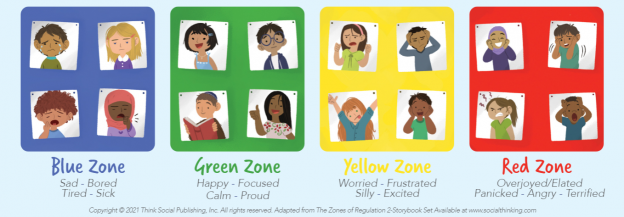Address:
William Patten Primary School
Stoke Newington Church Street
London N16 0NX
Office Manager: Rita Quigley
SENDCo: Caitlin Shaw
William Patten Primary School
Stoke Newington Church Street
London N16 0NX
Office Manager: Rita Quigley
SENDCo: Caitlin Shaw

Zones of Regulation is an approach that supports the use of a consistent shared language to discuss emotions. Emotions are grouped into four colour zones which represent different groups of feelings. The idea of zones is to take a non-judgmental approach to discussing and supporting children with their emotions. All emotions are natural to experience and we can learn to recognize and manage our feelings in different contexts.
We use the Zones of Regulation to encourage children’s ability to:

The Zones can be compared to traffic signs:
How do we use the Zones of Regulation in School?
What can I do as a parent?
Here are some examples from the four zones:
Blue – I can see and hear that you’re crying, your mouth is turned down, are you feeling sad?
Green – I can see your big smile and hear your laughter, are you feeling happy?
Yellow – You have become very quiet and I can see that you are reluctant to speak, are you feeling worried?
Red – I can hear that you are breathing heavily and I can see that your eyebrows have bunched together, are you feeling angry?
Discuss why they are feeling a certain way, has anything happened?
Talk about times when you, a family member or a character from a film or book felt that way.
The Tool Box
We encourage children to think of the strategies that they use to support them when they are in a zone as their ‘tools. ‘The ‘tool of the week’ will be published in the Patten Pages.
You could try that with your child and discuss what zone it might be good for.
Deep breathing is one of the many beneficial strategies to teach your child. Your child can learn to change short, shallow breaths that can cause hyperventilation to deep, long breaths that help create a feeling of internal calmness. Short, shallow breaths tend to make feelings of anxiety and anger worse, hence calm breathing can give your child a sense of control and relief.
Yoremikids has some great breathing techniques, click on the link to give them a try.
https://www.yoremikids.com/news/best-breathing-exercises-for-kids